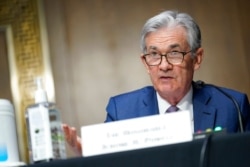Consumers around the globe face higher prices for a wide variety of everyday purchases, as supply chain problems bedevil markets for all manner of goods, and energy prices spike to highs not seen in years.
That means consumers around the world are paying more for items like food, clothing and household supplies, and for major purchases like cars, appliances and homes. The impact is felt most acutely by low-income families, who find that their limited incomes cover fewer of their immediate needs than before.
The question on the minds of many economists, however, is whether surging prices really are "transitory," as senior officials in the United States have been saying for months, or are they the beginning of a period of more sustained price growth than most of the world's major economies have seen in decades.
In testimony before Congress last week, Federal Reserve Chair Jerome Powell said that "frustrating" global supply chain problems resulting from the end of pandemic lockdowns have extended a period of inflation longer than he and other central bankers had originally expected. But he said he remained confident that they would eventually resolve themselves.
"The current inflation spike is really a consequence of supply constraints meeting very strong demand, and that is all associated with the reopening of the economy, which is a process that will have a beginning, a middle and an end," Powell said. "We see those things resolving. It's very difficult to say how big those effects will be in the meantime or how long they will last."
Inflation concerns
Some economists, however, worry that the Fed is underestimating the forces driving prices on everything from food to automobiles.
"There are very many reasons to think that this inflation is not transitory — that it's going to be with us for quite a while," Desmond Lachman, a senior fellow at the American Enterprise Institute in Washington, told VOA.
On Tuesday, the price of the global benchmark for oil, Brent crude, rose to $82.56 per barrel, hitting a level not seen in three years. Worldwide, prices for food, fuel and consumer goods are on the rise.
The price of natural gas has more than tripled in Europe and Asia this year, leading to economic slowdowns in much of Europe and power cuts in China. Even in the United States, which normally has a plentiful supply of the fuel, prices are jumping on concern that there may be shortages in the winter months.
The big picture
In the United States, a widely watched inflation index, which excludes food and energy prices in order to minimize volatility, has been persistently above an annualized rate of 3.6% since the summer — far higher than the rate of less than 2% in recent years. Housing prices, a major element of inflation indices, are rising sharply.
Meanwhile, the Federal Reserve continues to pursue policies that make it cheap to borrow money, which many economists believe is creating more inflationary pressure.
"When you put the whole picture together, and you consider that the Fed has got its pedal to the metal at the same time as the administration is engaging in a record amount of peacetime budget stimulus, all of this doesn't look to me like inflation is coming down anytime soon," said Lachman.
Central bank tools
However, not all economists are as concerned as Lachman.
"In some sense [inflation] does seem a little more than transitory," Jonathan Wright, a professor of economics at Johns Hopkins University, told VOA. "If you'd asked me a few months ago, I would have been more confident that this was limited to a few special sectors," he said. "Now it seems to be something broader, the costs of shipping being a big part of that."
However, Wright said he agrees with Powell that the eventual resolution of the supply chain bottlenecks, like the current backlog of dozens of container ships off the coast of California and the glut of shipping containers at rail yards in the American Midwest, will address much of the problem. He said he doesn't anticipate prolonged inflation.
In part, he said, that's because central banks, like the Fed, have a better understanding of how and when to act against spikes in inflation than they did the last time the U.S. faced a major inflation crisis in the late 1970s.
"The Fed is very aware of the problem," he said. "If inflation comes in meaningfully above target next year, the Fed will tighten [monetary policy] quickly towards the end of the year."
Inflation expectations
A question related to the impact of supply chain pressures on inflation is whether rising prices could become a self-reinforcing phenomenon separate and apart from the economic realities driving them.
That could happen if consumers, as a group, come to believe that prices are going to continue to rise at a high rate, and therefore begin making purchases that they might otherwise have postponed. The injection of more spending into the marketplace would create the upward pressure on prices that the consumers were trying to avoid in the first place.
In a press call on Tuesday, Adam Posen, president of the Peterson Institute for International Economics, and Karen Dynan, a senior fellow at the organization and a professor of economics at Harvard University, responded to a question from VOA about inflation expectations.
Dynan said that she didn't expect a relatively short period of inflation to move public expectations very much.
"We have had decades in the United States, and in some other rich countries, where inflation has been at 2%. Over the last decade, it's been kind of hard to keep it that high. So I don't know that the experience of a few months is going to kind of undo all that," she said.
Posen said he believes that the effects of consumer expectations are "exaggerated" and that an aggressive anti-inflationary stance by the Fed, combined with broad international price competition, will help to keep inflationary pressures in check.












